Current Recommendations
_________________________“The Beatles Were Fab (and They Were Funny)” by Kathleen Krull and Paul Brewer
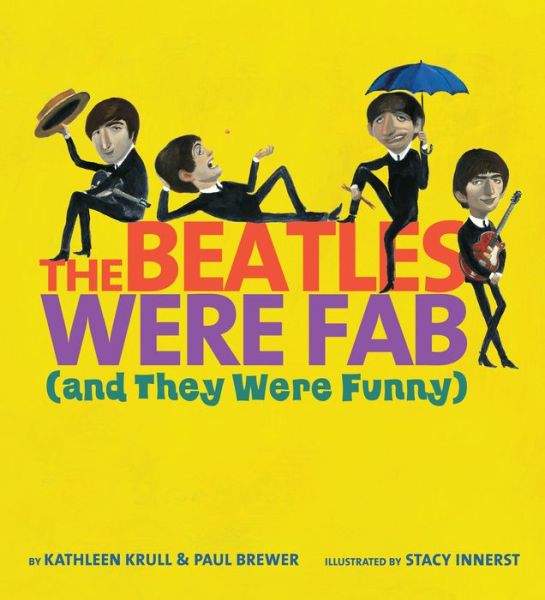
Authors: Kathleen Krull and Paul Brewer
Illustrator: Stacy Innerst
Publisher: Harcourt Children’s Books, 2013
Reviewer: Karla Stoffel, Carthage Student
If
you are looking for a hilarious, fun-fact filled story on the Beatles, Kathleen
Krull and Paul Brewer have written just the book. The Beatles Were Fab (and They Were Funny) is the story of four
Liverpool boys that “made music, made history, and made people laugh.” Kathleen
and Paul are not only a husband-and-wife writing duo, but also life-long
Beatles’ fans and their story brings the Beatles, a household name for children
of the 1960s, 70s, and 80s, back to life for contemporary audiences.
Told
as a narrative—interspersed with actual quotes from the Beatles—this book
outlines the Beatles’ story beginning with their early days as struggling
musicians in the dingy town of Liverpool. The number one emphasis in this book
is on the Beatles’ never ending use of humor as a means to keep their spirits
up despite the treacherous circumstances they encountered. Through accounts of
the Beatles’ rise to the “toppermost of the poppermost” and the spread of
Beatlemania in England and across the Atlantic Ocean to the United States of
America, Krull and Brewer interweave snippets of the Fab Four’s witty humor.
Stacy
Innerst, an artist in Pittsburg, Pennsylvania, accompanies Krull and Brewer’s
words with acrylic and ink illustrations that recreate the Beatles’ adventures
and also capture their joking nature. Innerst’s imaginative, eye-catching
illustrations add further intrigue to Krull and Brewer’s words. And with lyrics
from many of the Beatles’ more than 200 recorded songs incorporated in the
illustrations, it is hard to avoid singing along as one reads.
The
Beatles are a timeless band that reached an unsurpassed level of fame. Krull,
Brewer, and Innerst have created a masterpiece of children’s literature that
accurately portrays the craze of the Beatles and their rollercoaster journey
from Liverpool boys to world-renowned performers. Through Krull and Brewer’s
ingenious integration of humor into a nonfiction text, along with Innerst’s
imaginative illustrations, this book is a successful effort to make nonfiction fun,
entertaining, and appealing to young readers. Krull and Brewer have also
included a brief set of endnotes that include a chronology of “Important Dates
in Beatles History” and a list of sources. A treasure of a piece of children’s
literature, The Beatles were Fab (and
They Were Funny) is not only a factual account of the Beatles’ rise to
fame, but also a reminder of the importance of humor.
“Want to Be in a Band?” by Suzzy Roche
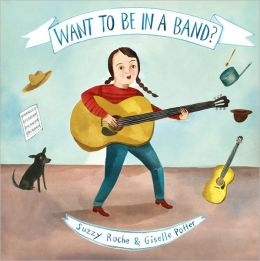
Author: Suzzy Roche
Illustrator: Giselle Potter
Publisher: Schwartz and Wade Books, 2013
Reviewer: Karla Stoffel, Carthage Student
Suzzy
Roche’s cleverly written story, Want to
Be in Band?, disguises a first-person memoir as a second-person advice
narrative. Suzzy Roche is herself a musician. She has been playing with her two
older sisters, Maggie and Terra, since they were young, and formally became the
folk-indie rock band, The Roches, in the 1970s. This band thrived for more than
thirty years, enjoying numerous performances across the country, recording
eleven records, writing music for TV and movies, and collaborating with other
great musicians.
Want to Be in a Band? tells Suzzy Roche’s personal story in
second person, inviting the reader to consider his or her own interest in
forming a band. Through tones of encouragement, seriousness, and silliness,
Roche explores the journey it takes to become an active performing band. Want to Be in a Band? reveals the many
struggles, as well as thrills, that one is likely to encounter along their
journey from learning how to play the guitar, to traveling the country,
performing in front of zillions of fans. According to Roche’s story, making
music in a band takes an incredible amount of hard work, cooperation,
enthusiasm and, don’t forget, practice!
In
Giselle Potter’s traditional style, the colorful watercolor and ink
illustrations bring Roche’s words to life. The variety of colorful illustration
layouts, from double-page spreads to snapshot images, contribute to a story
that is both enjoyable to read, and also aesthetically pleasing to look at.
From providing readers with an attractive second-person advice story to
generating excitement about making music through diligence and cooperation,
Suzzy Roche’s story and Giselle Potter’s illustrations work together to create
an attractive story for young readers.
Author: Anna Harwell Celenza
Illustrator: JoAnn E. KitchellPublisher: Harcourt, 2013
In the mid 19thcentury the streets in Paris were full
of life, though underneath the city is a cemetery which fascinated people to
the degree that these catacombs were open for people to visit. The widely
respected composer, Camille Saint-Saens was one of the many visitors. The
result has become one of his most popular pieces of music.
For those not familiar
with this piece the publisher has included a CD with a performance by the
well-respected Pittsburgh symphony led by one of the most important
contemporary conductors, Lorin Maazal. The author and illustrator have here
produced the 8th title in a very popular series. It runs from Bach
to Ellington. Celenza deals with only part of the composer’s life, well written
to bring his thoughts and words to life for young children. A prominent poet of
the time, as well as a very popular singer also included in the action
surrounding the composition of this ballet.
Kitchell’s art continues
the visual approach in the earlier books. A firm black pen line outlines
naturalistic colors with little attempt to create the third dimension. Celenza,
a professor of music, presents authentic research in an author’s end note,
though the book itself can communicate with children without this.
An interesting aspect of this particular book is that it describes
the reaction when the work was first performed. Some people in the audience
applauded but others shouted their displeasure, for instance “Scandalous!” How
interesting that the work elicited such strong feelings in the same way that
Stravinsky’s *Rite of Spring did. Musicians who explore the boundaries
of conventional composition, like **Charles Ives, are often not appreciated
until much later.
Authors of books for
children about the arts are particularly important in this era when children
are far less likely to encounter music and arts program in the schools. The job
of acquainting children with the arts thus often falls now to grade level
generalists who can certainly appreciate the help that books like this offer
them.
*Book about this by Lauren
Stringer is review elsewhere in the “music” blog section.
**See Charles Ives Review
elsewhere in the "music" blog section
Click here for Purchase and
Inquiry.
"Handel. Who Knew What He Liked." By M.T. Anderson
Author: M.T. Anderson
Illustrator: Kevin HawkesPublisher: Candlewick, 2013
George Frideric Handel (1685-1759)
will be largely unknown to most of the intended audience- middle school
children. Author Anderson (http://mt-anderson.com/)
manages to include a lot of information. He has written short (2-3 double page)
chapters in language which is compact in amount and in length of sentence. To
balance the information load, Anderson provides many amusing anecdotes about
the headstrong composer who had no doubts, at least throughout most of his life,
about his own ability. After a disagreement which led to a duel with a composer
friend, the two men went out to dinner. There are also humorous asides in the
author’s voice, ie: in describing Handel’s satisfaction during one performance,
Anderson says we can imagine Handel “Waggling his wig.”
Illustrator
Hawkes (http://www.kevinhawkes.com/home.htm)
is able to use the constrained amount of space available for his art, to create
pictures which enliven the text. The vertical rectangle trim size (6w x 9 1/4h)
is limiting. But Hawkes’ use of chiaroscuro is indeed impressive. Throughout
the art, he draws attention to particular critical details. For example, the
contrast between the intense whiteness of Handel’s wig when playing, back to
the viewer but facing the subdued light in his audience, gives an impressive
sense of time and place.
Aware
that most young readers will be unfamiliar with objects (like a clavichord),
musical forms (like opera), or processes (pumping organ bellows), Anderson
provides discrete footnotes as necessary. In addition, extensive end matter
accompanies the retelling of Handel’s life, in complete form from birth to
death. A chronology of his life, a discography, an author’s note, selected
sources, and an index are all provided. This is an admirably manageable
introduction to a prolific composer who worked in many different musical forms.
Teachers
and librarians unfamiliar with Handel’s music could go to www.classicsforkids.com/composers/bio,
which includes an audio recording of his music.
"The Man With The Violin" By Kathy Stinson
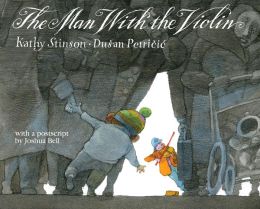
Author: Kathy Stinson
Illustrator: Dusan Petricic
Publisher: Annick Press, 2013
Taking an actual event, Stinson
weaves it into a compelling story about young Dylan, who is far more aware of
things around him than is his mother. A trip downtown takes them through a busy
subway station and Dylan is distracted and then entranced by the magic of the
music he hears a street musician playing. The effects of the music remain with
Dylan throughout his day and he recognizes the playing when he and mom hear it
on the radio later. At book’s end, mom is finally caught up in listening, and
they are both transported. So transported, in fact, that as they swirl with the
music, she loses a slipper, and the pattern on the rug becomes airborne as
well- a nice visual touch!
Petricic has won awards from the
Canadian Children’s Book Center and the Canadian Library Association for his
illustrations. Here, the visual “noise” of the surrounding crowds is depicted
in shades of grey, which contrasts with and underlines the full color swirls of
the enticing music, which transports Dylan while the crowds and his mother
remain oblivious. What makes crowds oblivious- their everyday tasks done while
commuting, ie: checking cell phones, eating and drinking while walking, and
minding the baby. They are so indifferent that, as end matter reveals, when the
real Joshua Bell ended his playing, though 1000 people had walked by, only
seven stopped to listen.
Extensive end matter
includes the author’s factual explanation of the actual event she has woven
into her fiction. There is also a Postscript by Joshua
Bellthe world renowned violinist who agreed to do the concert requested by
a newspaper which wanted to test public reaction or obliviousness to his
playing. In his commentary, he makes the distinction between hearing and listening, something which we should help children understand, for
the richness it would contribute to their lives.
Click here for purchase and
inquiry.
"When Stravinsky Met Nijinsky." By Lauren
Stringer
Author: Lauren Stringer
Publisher:
Harcourt, 2013
The works of this composer (1882-1971)
and dancer (1889-1950), changed the face of modernism in those arts. Of the
two, Stravinsky is the better known to audiences today, though indeed he isn’t widely
known beyond classical music fans. Nijinsky, the best known
dancer of his era, is almost completely unknown today, apart from dance
enthusiasts. When the two met, and created the Rite of Spring (Le Sacre
du Printemps) they may not had been aware that they have been creating an event
of sound and movement unlike anything else which preceded it.
The story line describing this event
includes a well-crafted parallel description of the people in the audience who
loved the production and those who hated it. Reports on the riot which occurred
at the conclusion of the 1913 premier was widely reported in the popular media.
The
aural and visual images which author Stringer composes with her
words are impressive. For example when Stravinsky composed by himself , “his
piano trilled an orchestra…”When Nijinsky
composed dances by himself,“his legs leaped- a deer!” . These images contrast
effectively with that Stringer writes for Stravinsky (“His piano pirouetted a
puppet…") and for Nijinsky (“His torso trumpeted a melody…”) She continues
with interesting patterning in writing in describing the audience divided
reation at the premiere. “They stood on their seats and shouted: “Boo! Boo!
Boo! “ contrasted with : “They stood on their seats and shouted: Bravo! Bravo!
Bravo!”
The author provides extensive end
matter, including a description of how she came to research and write this duo
biography, brief factual paragraphs about each of the men, other material about
the dance itself, and finally some notes about her creation of the art for the
book. All of this is quite interesting to adults but probably won’t be of much
interest to children. This rises as do some other recent picture books about
important adult creators in the arts. A question to be considered: Who is the
audience for such books? Kathleen T. Horning deals with the important question
of audience in her article about Madeline's Rescue (The Horn Book
Magazine, May/June, 2013 P35-41).
For further information about these
creators:
"The Bear's Song" By Benjamin Chaud
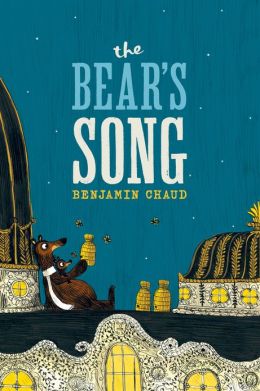
Author: Benjamin Chaud
Publisher: Chronicle, 2013
Benjamin Chaud combines a wonderfully
funny, wry fantasy about Papa Bear who must go find his Little Bear which
involves a trip to the opera house. This tale is presented in an impressively
elegant format and art style. What results is an appealing book for young
readers. Open the tall (14” h) book to discover a honeycomb pattern on the end
papers replete with bees to get a preview of what starts the action. Papa Bear
is ready to hibernate but Little Bear hears the siren song of the honey bee and
follows it through the woods, into the city, and past the tall apartment
buildings which are obviously derivations of a Paris landscape. Papa Bear
follows Little Bear who follows the bee and that leads to an adventure at the
opera house, which results in Papa Bear ending up on stage. His roar empties
the opera house and the story comes to pleasant end as the two hibernate
together, in an unexpected place.
The
purposefully limited color palette includes blocks of color defined into shapes
by a pervasive encompassing ink pen line. The author/Illustrator delights in
providing myriad details for children to explore. We can see for instance, in
the panoramic view of the opera house lobby, people arriving, socializing at
small tables, musicians arriving and waiters delivering drinks. The cut-away
backstage view on the next page shows actors putting on makeup, set movers
doing their work, and even the maintenance man tending the furnace.
The
vertical shape of the book is enhanced by the artist’s decision to have all the
openings be double page spreads. So with a full 18” wide to provide tiny space
for details, there is much to see. After you’ve enjoyed the whimsical story
line, ask children what they notice on a page. They might, for instance, notice
the action as Papa Bear runs through the forest after Little Bear. This
includes a skunk observing from behind a bush and two wood cutters high up in a
tree while a little boy runs to get closer to see the action. Are those wild
boars running to get away from the bear? In all, a delightful experience laced
with a lot of hilarity.
Click
here for purchase
and inquiry.
Previous Recommendations
_____________________
"Spirit Seeker: John Coltrane’s Musical Journey” by Gary Golio
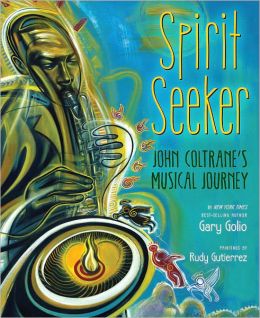 Author: Gary Golio
Author: Gary Golio Illustrator: Rudy Gutierrez
Publisher: Clarion Books, 2012
Reviewer: Karla Stoffel, Carthage Student
Spirit
Seeker: John Coltrane’s Musical Journey tells the story of a jazz saxophonist born in
North Carolina in 1926. A relatively unfamiliar musical figure to those who are
not jazz enthusiasts, John Coltrane’s life story is one of
great loss, hardship, and spiritual journey and transformation. Coltrane grew
up surrounded by music and religion—his mother was the organist at the local
church where his grandfather preached and his father was an amateur
musician—and both music and religion would continue to be defining influences
throughout his life.
Gary Golio’s picture book about this
jazz extraordinaire begins in a small, warm church in High Point, North
Carolina in 1938. At age twelve, Coltrane’s life was filled with laughter, fun,
and with music. This, however, changed very quickly with the death of his grandfather,
father, grandmother, and mother’s father all within two years. John and his
family were devastated, and became desperate for money. During these times of
hardship, John turned to music for emotional expression and healing. John began
to learn the saxophone in high school and he found that making music made him
happy; it brought life back into him. Moving to Philadelphia, a city
overflowing with jazz and blues, after high school, John began to make a name
for himself. Rich with metaphors, Golio’s text follows Coltrane’s story as it
winds through struggles with drug and alcohol addiction, musical
experimentation, soul searching, and spiritual cleansing.
Rudy Gutierrez’s illustrations are the
perfect match for Gary Golio’s rich text. Gutierrez’s flowing and vibrant
double-page spread acrylic and mixed media illustrations are more than colors
on the page. With each brush stroke Gutierrez brings to life not only John
Coltrane, but also his music. The layered, loose brush strokes seem to
represent the deep, soulful jazz music of Coltrane’s saxophone. In a dual
manner, Gutierrez’s illustrations also mirror the emotions of the text. Every
time the reader turns the page he or she is struck with an image full of emotion;
before one reads any words on the page he or she has a sense of the emotional
content.
This picture book, not
intended for young readers due to its drug and alcohol references, also
includes endnotes that supplement the book’s primary text. Included in these
endnotes is an afterward that provides additional details about Coltrane’s life
and an author’s note on how Coltrane’s substance abuse effected his life and
music. There is also an artist’s note telling of Gutierrez’s goal to honor
Coltrane’s inspiration through the illustrations in this book, and a list of
sources and recourses.
Gary Golio and Rudy Gutierrez have created a genuine work of art.
An eye-catching visual and an engaging read, Spirit Seeker is the story of how life circumstances changed John
Coltrane’s music, and how music transformed John Coltrane’s life. When finished
reading, the reader will wish there was more.
"Harlem’s Little Blackbird. The Story of
Florence Mills.”by Renee Watson
Illustrator: Christian Robinson
Publisher: Random House, 2012
Big, bold, beautiful and simple! Large
swatches of vibrant, unmodulated color engage the reader and attest to the
value of repeated elements in design. Patterns on clothes, on buildings, even
on room arrangements make a pleasant repetition. There is much excitement here,
for instance, on the 8th opening, in which Florence sweeps across
the double page spread, in an abandoned gesture which reflects her excitement.
It was unusual for a black woman to land a role on a New York City stage in a
sold out show which introduced Jazz to white audiences. At the time of the Harlem
Renaissance (1918–1937/),
important creators of the arts, such as, Langston Hughes and Duke Ellingtonwere at work. Florence
was in the midst of it, though white audiences in both the US and London were
resistant until her singing won them over.
Florence
(1897-1927) goes from a childhood in a “teeny-tiny, itsy-bitsy house,” to using
her voice to sing her way around the world. Watson has given us a story of a
performer whose reputation has indeed dimmed over the years, but she has
brought this convincing biography to life. The mixed media pictures by Robinson
couldn’t have been more effective.
Click here for purchase and
inquiry.
"Tabby McTat. The
Musical Cat " by Julie Donaldson

Author: Julie Donaldson
Illustrator: Axel SchefflerPublisher: Scholastic, 2012.
Though many
children will be unfamiliar with the concept of street buskers, the idea is
thoroughly understandable as presented in this fine story about a best friend
lost, and then found. Buskers perform in public spaces for money, by dancing,
singing, clowning or playing musical instruments. In this case, Tabby meows
loudly to accompany his friend, Fred’s, playing on the guitar while singing.
But, one day Tabby’s eye is caught by an attractive feline and while they are
engaged in conversation, a thief steals Fred’s hat with money and that
precipitates a trip to the hospital. Lost to each other, McTat does find another
home but despite domestic bliss with his friend Sock, he still misses Fred. In
the end there is a joyful reunion and McTat’s son Samuel takes over as Fred’s
accompanist.
Large full
page art combines with some facing pages of eight small vignettes. The art in
deep, rich colors outlined in black, conveys the urban environment effectively.
Click here for purchase and
inquiry
“The Extraordinary Music of Mr. Ives” by Joanne Stanbridge
Publisher: Houghton Mifflin, 2012
Even the most
devoted music fans can find the compositions of Charles Ives (1874 –1954) to be a challenge. To say that his music is an
acquired taste is an understatement. Multiple rhythms at the same time and
multiple key signatures happening simultaneously make serious demands on adult
listeners. So what is there about this man and his work that would make him a
suitable topic of a children’s picture book?
Author
Stanbridge has set the composer’s work within the context of the 1915 sinking
of the ocean liner, Lusitania. The simplified art, watercolor contained in a
firm black line, is positioned on full pages, bled to the edge without borders.
These alternate left and right sides of the openings, facing a narrow vertical
panel on the opposite page. She uses five wordless double page spreads to
convey the impact of that disaster. The old hymn “In the sweet bye and bye…” is
certainly a very different composition than the one which Ives subsequently
created as his response to the sinking of the Lusitania.
An interesting feature of the book is the three panels
featuring composers whose work “echoes” Ives. These include: Elliot Carter
(1908-2012) (a ballet score); Aaron
Copland(1900-1990) (an Opera); and John Adams (a
concert piece) (1947). The book concludes with an Author’s Note as well as
recommendations for further reading. There is no CD in a jacket but the list of
further reading includes two internet sources where one can listen to the music
of Ives.
There is an
interesting parallel in the lives of Ives and the French primitive painterHenri
Rousseau (1844 –1910). Both of
these were people with exceptional creative talent, though without formal
training in their art form, who spent most of their lives working at other jobs
and created only once their work day was finished.
Click here for purchase and
inquiry.
"Vivaldi and the Invisible Orchestra" by Stephen Costanza
Author: Stephen Costanza
Publisher: Holt, 2012
Reviewer: Barbara J Michaels
This is a perfectly sized book to share with children
who will be attracted not only to the interesting jacket/cover but also by the
bright green end papers. The equally rich illustrations, most of which sweep
across the gutter to create double page spreads, are augmented with a few
smaller illustrations. Some of these are close-ups, others provide more distant
views.
The
book is a rich trove of vocabulary, such words as concerto, bassists pondered,
and frightful are among others. Costanza also uses language to provide
interesting images such as: comparing violins to glittering stars, the room
was“awash in sound,” and suggesting that a concerto about night must have
moonlight in it. This picture book format might suggest younger children but in
upper grades teachers could use the imagery to get children to think about
creating their own imagery.
The author’s note on the last opening will be helpful
to teachers. In a time of the distressing disappearance of public school music
programs, books such as this are extremely helpful. Readers might want to also
search out a copy of Costanza’s Mozart
Finds A Melody (Holt, 2004)
“Music Was It. Young Leonard Bernstein” by Susan Goldman Rubin
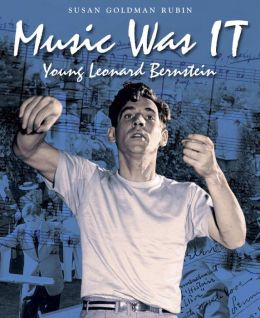
Author: Susan Goldman Rubin
Publisher: Charlesbridge, 2011
Reviewed by: Gail Navratil, Retired Teacher
Music
Was It is such a perfect title for Susan Goldman Rubin's biography of
Leonard
Bernstein's early years. Every page conveys his burning passion for music.
As a very young boy Leonard would relentlessly beg and cry for “Moynik” (his
word for music) until his mother would put a record on the old windup Victrola.
He paid for his piano lessons by saving almost all his allowance, funded some
of his schooling by playing in halls and clubs and earned the rest by giving
piano lessons to young students. During the summers Leonard put on musical
shows; and at any time of the year, could be found playing the piano until all
hours of the morning.
His
father, Sam, strongly discouraged Leonard from pursuing his love of music,
because all he knew were the street musicians from his native home in Russia
who made little for their “songs”. He wanted his son to “make a living”,
specifically to take over his thriving New England business selling barber and
beauty supplies for a company in Boston. Despite Harvard’s high tuition, Sam
agreed to pay for Leonard’s schooling hoping his son would “concentrate on
something practical like economics”. Lenny, of course, chose Harvard’s Music
School and helped to pay for expenses by winning grants and scholarships. Sam
drew the line when his son announced he had been accepted into the conducting
class at Curtis Institute of Music. Not until his son made his debut at
Carnegie Hall conducting the New York Philharmonic, at the young age of 25, did
Sam express his acceptance and pride.
Rubin’s book is a quick and easy read.
Middle and High School students will love browsing through the numerous
pictures complete with musical scores, doodles and cartoons. Rubin even
includes a picture of Miss America receiving a permanent wave with a newly
invented machine that looked like something from outer space, a machine for
which Sam purchased a license. Any child who experiences a true passion for an
art, hobby or vocation which meets with parental disapproval will be encouraged
to forge on and find ways to pursue his or her “love” as did Leonard Bernstein.
Extra
bonuses in the back are brief biographies of key people in Bernstein’s life
along with a timeline and sources of quotations. In the beginning of the book
on a page all by itself is a quote which sums up so well the driving force
behind Leonard Bernstein’s actions: “Life without music is unthinkable”, and so
it would be.
Click here for purchase and
inquiries
"Jazz Fly 2. The
Jungle Pachanga" by Matthew Gollub
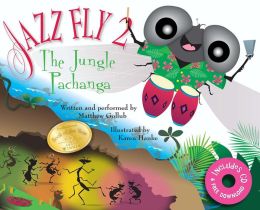
Author: Matthew Gollub
Illustrator: Karen Hanke
Publisher: Tortuga Press, 2010
Sharp
edged, brightly colored and highly patterned 2-d art
shows the main characters (sloth, spider monkey, and Macaw) and a large number
of incidental characters. The trip to the Termite Nook is dependent on a
variety of different transportation modes, each of which fails. When the
pachanga, or dance party is at its peak, danger lurks in the form of an ant eater
but all ends well because of a helpful jaguar.
There’s much language learning possible within this happy tale.
Forty words in Spanish (in pink), and English (in green) on the end papers face
solid color end pages. The book is vocabulary rich, using such terms as pupa,
pomade, and larva. Children can also learn about such musical instruments as
congo, maracas, claves, and timbales.
Typefaces which vary in size and color are scattered here, there,
and everywhere across the pages adding to the energetic feeling. The book also
includes an Author’s Note, providing information primarily intended for adults
but contains some information which might be shared in simplified form with
children, such as the jazz term, scat, and swing.
A useful addition is the audio CD provided in a jacket in the
front. An introduction by Gollub encourages children to listen
to the Spanish words and the jazz terms, as the author narrates the complete
book text with background by instruments listed, above as well as bass, piano,
and sax.
Click here
for purchase and inquiries
For an additional list of titles including another book by
Gollub see, "Staying in Tune" by Elizabeth Joan Kelly in the magazine
Children & Libraries, Summer/ Fall 2012 pg.42-46
“Strange Mr. Satie” By M.T. Anderson
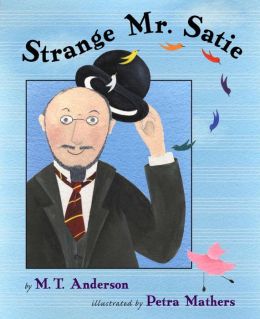 Author: M.T. Anderson
Author: M.T. AndersonIllustrator: Petra Mathers
Publisher: Viking, 2003
M.T. Anderson tackles a difficult job,
describing the erratic life of a composer probably little-known to children of
picture book age. Though in flap copy Anderson attests to his own childhood
appreciation of the avant garde composer's work, it is unlikely that youngsters
today will hear the compositions. Given the disappearance of school music
programs, it is as an adult that most people might meet GYMNOPEDIES, probably
the composer's most often performed piano work. Satie was born (1866-1925), in
an age which valued conformity and tradition. Despite this, "...he wanted
to make a new kind of music...that followed no rules but his own." In a
famous cafe, The Black Cat, he could perform his music for appreciative
audiences. Because it was "...the farthest thing possible from the world
of rules" it was a good place for Satie.
After a quixotic determination to return to school at age 39,
where he learned traditional music rules satisfactorily enough to graduate, he
continued to explore his own musical ideas, including composing for several
ballets. At the end of his life, persisting, he died in poverty, alone.
However, Anderson ends this account of an unusual and unfamiliar life on a
positive note, commenting about Satie's music, it had a "joyfully spinning"
quality, which delighted the composer. The important unstated moral of the tale
is encouragement to readers to persist in whatever they are driven to create,
whether or not acclaim from others results.
What
an inspired choice to select Petra Mathers to
illustrate the book, as her quirky art indeed matches the
"strangeness" of Satie's work so effectively! She uses her
characteristic style which is immediately recognizable to adults who have
enjoyed her other work (Sophie
& Lou). Mathers includes so many delightful visually unexpected
details that the reader gets reinforcement for the words of Anderson's
retellling of the quirky life of the composer. Endpapers including tiny
vignettes (like a blimp with Satie's quotation, "Why must everything be
explained?") introduce the idea that something unexpected will follow.
Other examples: a formally attired gentleman lifts his hat to greet another and
the small bird sitting on top of the greeter's head is revealed, though not
mentioned in the text. On the page depicting Le Chat Noir cafe, cats' heads are
everywhere, though two of the patrons sport headgear featuring a large insect
and another, a clock face. On another page, depicting a Satie-created ballet entitled
"Cancelled," Mathers shows a male ballet dancer in a pink tutu who
sports a beard and boxing gloves. Again, with no particular connecting mention
in the text. All of this recreates the purposeful nonsense that Satie shared
with visual artists, such as Marcel Duchamp (1887-1968) who astounded the art
world.
**to listen to a piece by Satie click here
**to listen to a piece by Satie click here
Click here for purchase and
inquiries
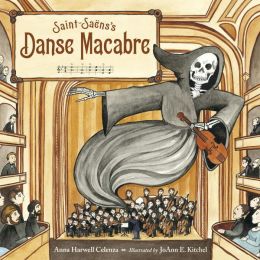
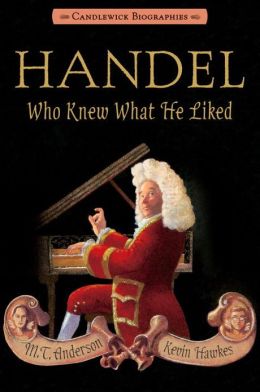
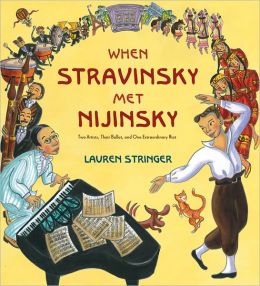
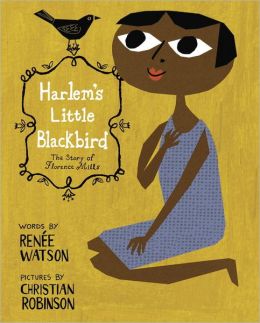
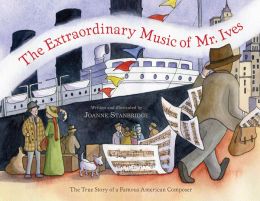
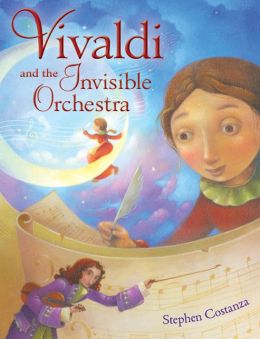
No comments:
Post a Comment